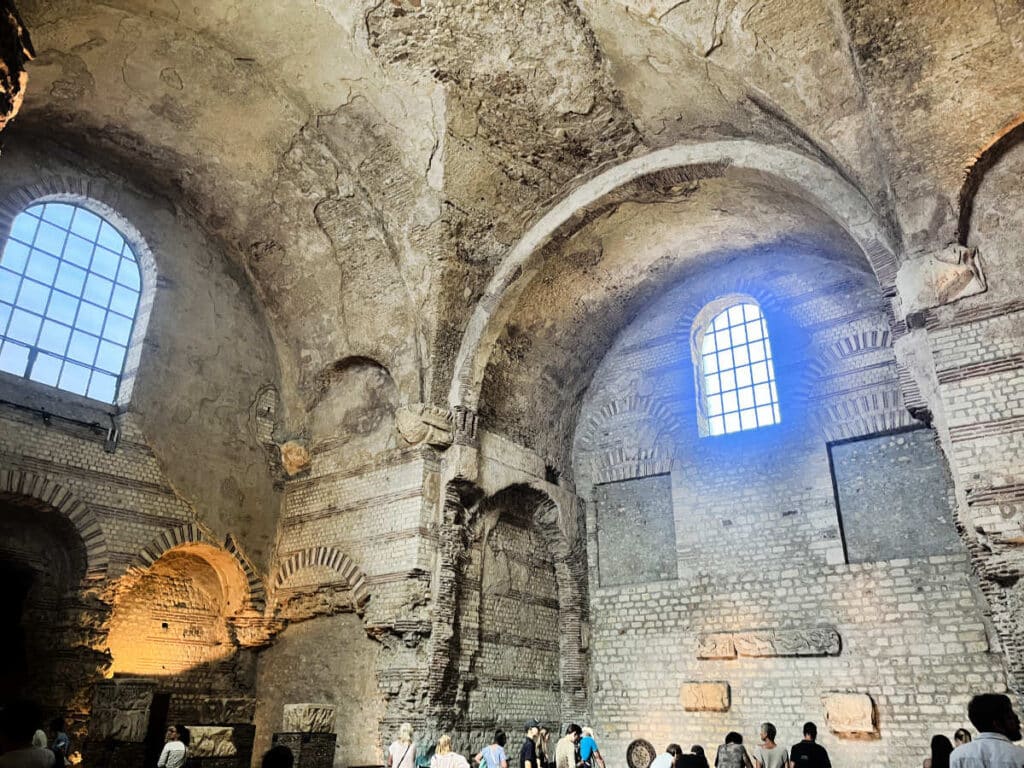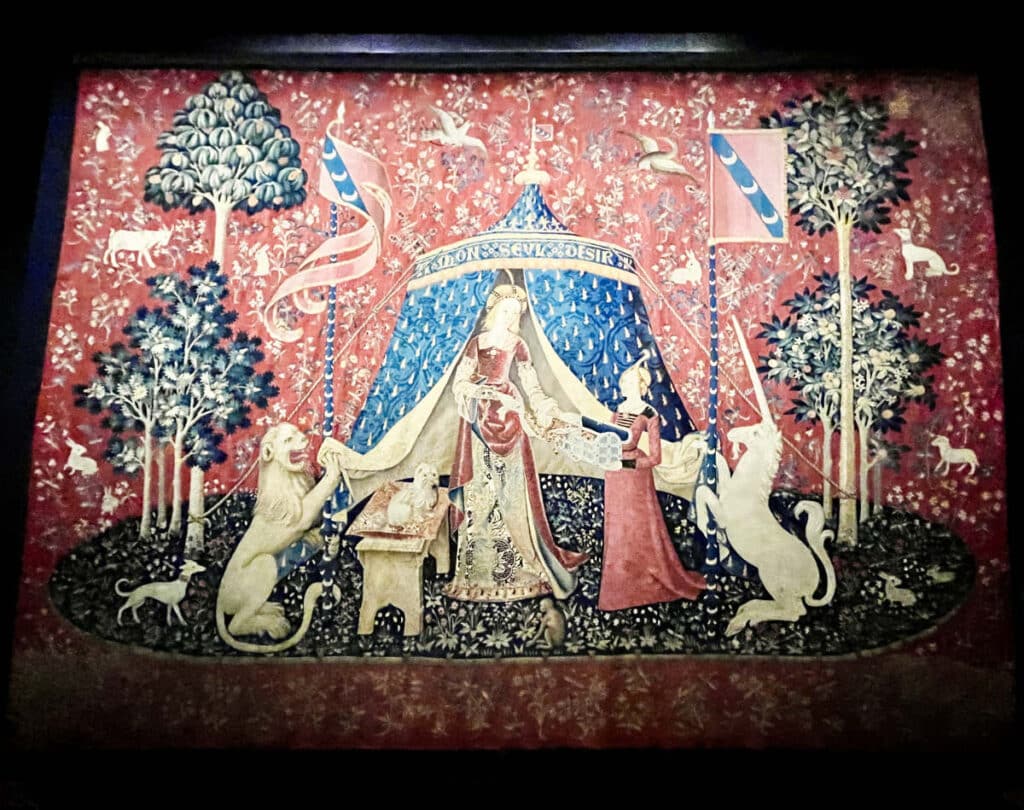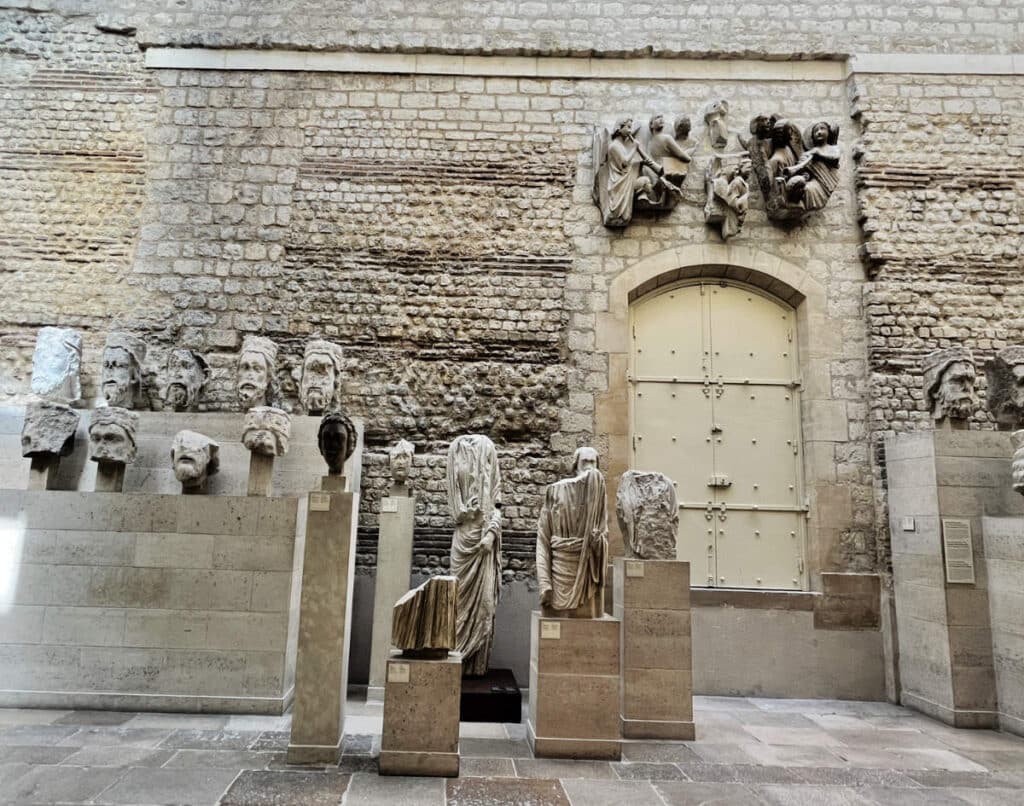It isn’t one of the most famous museums in Paris, but Musée de Cluny is one of those hidden treasures that is well worth a visit. It is located in one of the oldest parts of the city, in the 5th arrondissement. The building that it is in is just as intriguing as the museum itself.
The Cluny museum is based in a historic old abbey that itself was partially constructed on the remnants of the 3rd century Gallo-Roman baths. The baths were known as the Thermes de Cluny in the Roman era, giving the abbey and now the museum its name. You can buy tickets for the museum here.
History of the building
Vestiges of the large thermal baths from the 3rd century are still visible at Musée de Cluny, similar to other roman cities like Arles and Nimes. Along with the Arènes de Lutèce, the Thermes de Cluny are among the scarce visible reminders of the Gallo-Roman period still visible in Paris.

In Roman times, the thermal baths were situated in northern Lutèce were along what is today the Boulevard Saint-Michel and Boulevard Saint-Germain.
With an area of around 6,000 m², they were the largest public baths in the city, It included three levels with a deeply buried hydraulic network with a variety of conduits, service rooms in the basement, and finally a ground floor with frigidariums (cold rooms) and caldaria (hot rooms).
The Cluny order of monks acquired the ancient thermal baths in1340 and rebuilt the building as a hôtel de ville (private residence for the monks) next to their abbey in a combination of Gothic and Renaissance style.
Mary Tudor, the sister of King Henry VIII of England, was held here in 1515 after the death of her husband French King Louis XII. Louis died without a male heir, so his son-in-law King François I of France kept her here to see if she was pregnant.
After it was clear she wasn’t pregnant, King François allowed her to marry her love Charles Brandon, 1st Duke of Suffolk at the Hôtel de Cluny. The marriage was held in secret here in 1515, and was not befitting her station as an English Princess and Dowager Queen of France as her brother Henry VIII was opposed to the marriage.

In the 18th century, the tower of the Hôtel de Cluny was used as an observatory by the French astronomer Charles Messier. The hôtel also housed the official printing press of the Queen Marie-Antoinette of France from 1774 to 1792 (when she was executed).
During the 1789 French Revolution the building was confiscated and in 1843, it was turned into museum.
Famous artworks in the museum
Along with the visible archeological remains of the Thermes and the abbey, the museum houses an extensive collection of art. Statutory artefacts date as far back as the Roman era of the city of Parisii, along with pieces of Byzantine and Coptic art.

There are extensive tapestries, stained glass, religious art pieces, and even pieces of jewellery. There are also illustrated books, altars from old European churches, various reliquaries, and even some Visigothic votive crowns from the Treasure of Guarrazar from the 7th century.
The Lady and the Unicorn
One of the most well-known displays at the Cluny Museum are the six tapestries of The Lady and the Unicorn (La Dame à la licorne). The tapestries were created in the style of mille-fleurs (“thousand flowers”) and were woven in Flanders from wool and silk around 1500AD.

The 6 tapestries are considered the finest one of the greatest works of art of the Middle Ages in Europe. In each one of the bright red and blue tapestries, a noble lady is presented with a unicorn on her left and a lion on her right. Other animals like a panther, monkey, and birds are also present.
Statues from Notre Dame Cathedral
Another of the notable works at the Cluny museum is some statues and heads that sit in a large hall within the museum.
These statues used to sit above the entrance of the Notre Dame Cathedral de Paris on Ile de la Cité, and were meant to represent a series of 28 stone figures from the Old Testament and Kings of France.

The original statues were taken from the cathedral during the French Revolution and beheaded with a guillotine. Years later, the statues of the Kings were found buried in the courtyard of a hotel particulier (private mansion) for safekeeping, still with their heads cut off.
When you see the heads at Musée Cluny, you will notice that the heads seem proportionately bigger than the bodies. This is because the statues were not built to scale since they were meant to be high up on the front of Notre Dame Cathedral, and seen from the ground.
The heads were made bigger so that from the angle on the ground, they would seem proportionate and impress all those who came to pray. These original heads are now kept in Musée Cluny in Paris.
The statues that you actually see today at the Notre Dame Cathedral (which is just a 5 minute walk away), are copies meant to appease the revolutionary French.
How to get there?
The Cluny museum is located in the heart of the Latin quarter of Paris, near La Sorbonne. Fittingly, the closest metro station on Line 10 is called Cluny-Sorbonne.
How long do you need in the museum?
It should take at least 2 hours if not half a day to visit the Cluny Museum. There is a lot of explore and the museum does get quite crowded during the busy summer season and on weekends. You can buy tickets for the museum here.

If you enjoyed that article, you may like to read more about the top museums in Paris. A bientôt!




